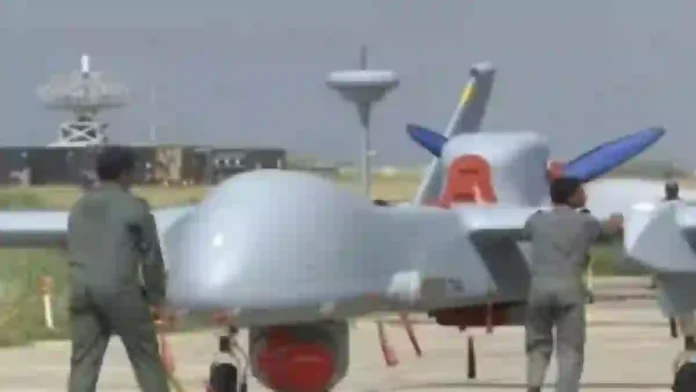India is moving to clear a ₹20,000-crore tri-service acquisition of 87 indigenously-made medium-altitude long-endurance (MALE) unmanned aerial vehicles (UAVs). Spearheaded by the Indian Air Force and demanding at least 60% local content, the proposal is slated for a high-level Defence Ministry meeting in the coming weeks.
Each system must remain aloft for over 30 hours at altitudes above 35,000 ft—performance that will give commanders round-the-clock eyes across the Line of Control, the Line of Actual Control and the Indian Ocean rim.
Read- Extended Range Anti-Submarine Rocket (ERASR); Know Its Key Features
Why The Acceleration And Why Now?
Operation Sindoor—a three-day, precision air campaign launched on 7 May 2025 after the Pahalgam terror attack—exposed both the reach of India’s forces and their appetite for persistent ISR (intelligence-surveillance-reconnaissance).
Pakistani retaliation involved massed drone and missile strikes; India’s integrated air-defence grid downed every inbound round but highlighted the need for deeper UAV stocks to keep hostile launch sites under constant watch. The Integrated Defence Staff subsequently completed a scientific study that fixed the requirement at 87 MALE platforms to seal critical surveillance gaps.
Complement To The MQ-9B Deal, Not A Substitute
India is already buying 31 (soon to be 32) HALE MQ-9B Predators from the United States for roughly ₹32,000 crore, with deliveries from 2028. Those drones will patrol at 40,000 ft for 40 hours but remain foreign-owned technology. The 87-drone MALE project therefore serves two parallel aims: fill the medium-altitude tier between smaller tactical UAVs and the high-altitude Guardians, and indigenise a capability so far dominated by Israeli imports.
Read- India Planning To Establish MRO Facility For S-400 Air Defence Systems Across The Country
Read- Army’s First Regiment of Long-Range ATAGS Artillery Guns To Be Ready
Who Can Bid And What Can They Offer?
India’s request for proposal is expected to invite at least six domestic champions. Their notional offerings and current credentials are summarised below.
| Company | Likely MALE Platform | Endurance/Ceiling | Recent Milestones |
|---|---|---|---|
| Adani Defence & Aerospace | Akshi 7 UAS | 24 h / 22,000 ft | Delivered Drishti-10 (Hermes-900 derivative) to Navy & Army; 36 h endurance, 450 kg payload |
| Tata Advanced Systems | Co-development ties with Israel Aircraft Industries (IAI) – upgraded Heron variant | 30 h+ / 35,000 ft (target) | Runs Hyderabad UAV integration line; built fuselage sections for MQ-9 under offset contracts |
| Larsen & Toubro | Indigenous MALE under “Black Knight” initiative | Data not public | Leads composite manufacturing for space & missile projects; eyeing rapid prototyping under iDEX |
| Hindustan Aeronautics Ltd (HAL) | TAPAS-BH-201 | 24 h / trialled to 28,000 ft | Facing altitude shortfall but Navy still ordering four airframes for maritime trials |
| Solar Defence & Aerospace Ltd (Solar Industries) | Nagastra-1R loitering munition (sub-MALE) | 60 min strike-loiter | Won ₹158 cr loitering-munition order; 75% indigenous content, CEP ≈ 2 m |
| Raphe mPhibr | Unnamed MALE prototype | 30 h / 35,000 ft (claimed) | Supplies lithium-ion batteries and avionics for existing UAVs; showcased mock-up at DefExpo 2024 |
All bidders must domestically produce airframes, flight-control computers, data-links and most sensors to meet the 60% localisation bar. Engines may initially stay imported, but additive-manufactured turbo-diesels under DRDO’s technology road-map could enter later batches.
Defence Ministerial data show that post-Sindoor emergency procurements have already cleared ₹40,000 crore in 2025, the highest on record. The MALE contract will inject another ₹20,000 crore, sustaining supply chains for composite structures, satcom terminals and electro-optics that also feed civil aerospace. Private equity analysts note Solar Industries’ market cap leaped from ₹1,000 crore in 2010 to ₹1.5 lakh crore after a string of loitering-munition orders; a similar uplift is forecast for UAV integrators once the 87-drone deal is signed.
Operational Pay-Offs Across The Services
Tri-service adoption will let the Army network MALE feeds with its new Nagastra and swarm-drone units for precision strikes in mountains, while the Navy pairs medium-altitude drones with Sea Guardians for layered maritime domain awareness. The Air Force can free up expensive Rafale-class fighters from routine patrol and channel them into offensive counter-air missions, a lesson underscored when one Rafale was lost to a technical fault, not enemy fire, during Operation Sindoor.
Chief of Defence Staff Gen Anil Chauhan argues that Sindoor proved conventional space exists below the nuclear threshold and that information dominance is the decisive variable. Persistent UAV coverage—secure, encrypted and armed if necessary—provides exactly that dominance.
Looking Ahead: Timelines And Risks
The Defence Acquisition Council is expected to grant Acceptance of Necessity within the next quarter, after which competitive bidding and prototype evaluations will run for twelve to eighteen months. If contract signature lands in mid-2027, first deliveries could start by 2029. The tight schedule risks being stretched if indigenous engines or SATCOM payloads lag; however, dual sourcing of subsystems and liberal technology-transfer offsets from the MQ-9B deal mitigate that danger.
While HAL’s TAPAS has struggled to hit the 30,000-ft mark, test data show steady gains, and the Navy’s limited order should keep the project technologically alive. Failure to close that gap could otherwise force India back onto foreign suppliers for the altitude envelope.
Conclusion
The 87-MALE drone project is not just another line item—it is the critical missing layer in India’s post-Sindoor surveillance architecture. By stipulating majority indigenous content, New Delhi is betting ₹20,000 crore that its private-public consortium can mature aero-engineered composites, long-range data-links and autonomous flight software in time to deter the next crisis.
If the bidders meet endurance and altitude goals on schedule, India will, for the first time, field a fully home-grown MALE fleet alongside imported HALE Predators, completing a sovereign UAV triad that ranges from shoulder-launched loitering munitions to space-linked deep-ocean sentinels.
Based On ANI Report
Agencies




